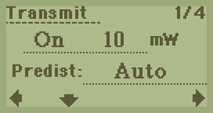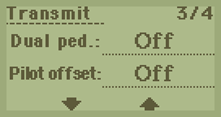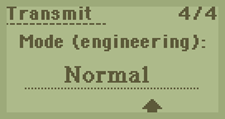Transmit power and frequency
Use this Transmit page to define advanced settings used to transmit the video signal. When you have selected the appropriate settings, toggle the joystick left to return to the main page. You must define the transmit power and frequency. Note that the transmit frequency set here and the receive frequency set on the receiver must be the same.
 |
 |
 |
 |
| Setting | Description |
|---|---|
| TX Power |
Defines the transmit output power. Toggle the joystick up/down to set the required power. Transmit power directly impacts signal range. The more power, the longer the range. Increasing the power can also make the signal more stable, but keep in mind it can have a negative effect on battery life. If the power is too low, the camera range may be insufficient resulting in loss of RF signal and video image. |
| Transmit Frequency (MHz) |
Set the transmit frequency assigned for your event. Set the current value, change the numbers to the required frequency and toggle joystick left to return to the main menu. Note that you can keep the transmit and receive frequency at the same value by selecting the Update Receive Frequency option from the receiver’s Remote Tx Crtl menu. Then, if you change the transmit frequency, the receive frequency automatically changes to the same value. |
| Bandwidth | Specifies the bandwidth of operation. For DVB-T, choose from 5 MHz, 6 MHz, 7 MHz, or 8 MHz |
| Constellation |
DVB-T offers three different modulation schemes: QPSK, 16QAM, and 64QAM. Lower order modulation formats like QPSK (Quadrature Phase Shift Keying) do not transmit as much data compared to higher modulation formats such as 64QAM (Quadrature Amplitude Modulation), but they can be received when signal strengths are lower. Note that as the QAM order increases, there is a higher possibility of introducing data errors since these schemes are less resilient to noise and interference. |
| Code Rate |
Match the code rate to the requirements of the broadcast network. The higher the level of error correction that is applied, the greater the level of supporting error correction data that needs to be transmitted, which reduces the data rate of the transmission. For example, if you select 3/4, for every 3 bits of data, you are sending out 4 bits, one of which is for error correction. |
| Guard Interval |
Choose the appropriate guard interval so that distinct transmissions do not interfere with each other. In DVB-T, four guard intervals are available: 1/32 provides the lowest protection and the highest data rate, 1/4 results in the best protection but the lowest data rate. |
| FFT/Carriers |
Choose the mode of operation, either 2K, 4K or 8K mode. Use 2K mode for single transmitter operation and for small single frequency networks with limited transmitter distances. Use 8K mode both for single transmitter operation and for small and large single frequency networks. |
Table 6: Transmit configuration
